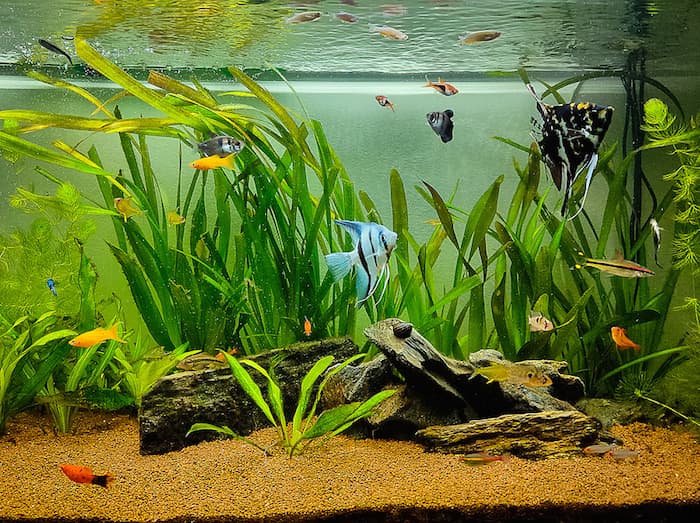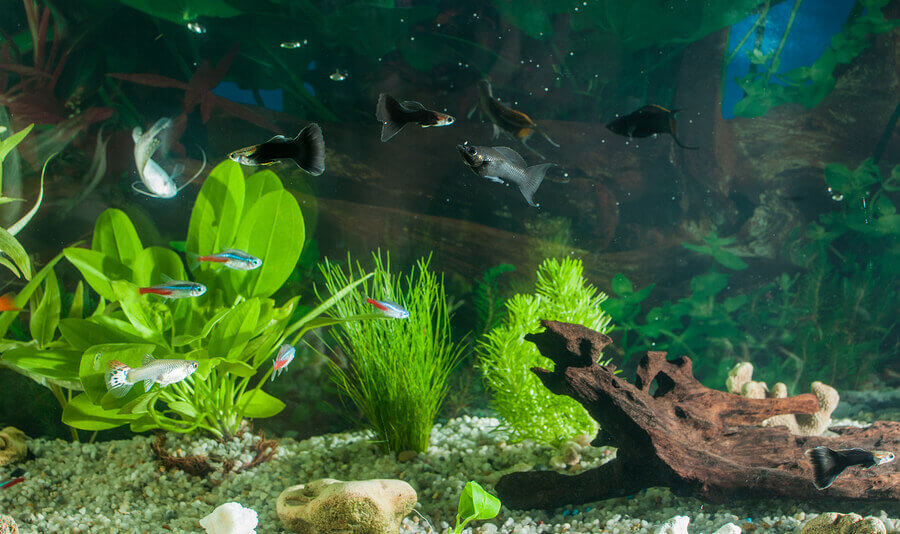Are you a hobbyist who loves the unique and eye-catching creatures of the deep jungle and ponds? Do you have a well-established aquarium, but you’re in the market for a new pet? Take a closer look at the Kuhli Loach.
This wiggly creature is known best for clearing debris and algae. They’re highly intelligent and just plain fun! This makes them the perfect addition to every home aquarium.
If this sounds like something you’d like to add to your tank setup, this simple Kuhli loach care guide is for you. Continue reading for everything you need to know about taking care of them!

Choose the Perfect Tank Setup
When setting up an aquarium, the Kuhli loach tank size and shape are important factors. It’s recommended to use at least 20 gallons. For a larger school of more than 5 loaches, a tank of 30 gallons or more is best.
A long tank with a cover is ideal, as this species enjoys jumping and can easily escape from tanks without covers. Also, use a soft and sandy substrate. This species burrows in the substrate when looking for food and resting.
Equip the tank with an efficient filtration system to keep the water clean. All in all, choosing the right tank setup for your Kuhli Loaches is key to creating a successful and ideal environment for them to live in.
Decor Suggestions for Kuhli Loaches
Provide plenty of hiding places with driftwood, rocks, and live plants like Java Moss. Plants provide additional nutrition for the loaches as well as an atmosphere of privacy.
Ornamental caves, clay pots, and coconut shells give hiding places. Driftwood and rocks provide shelters and can be arranged to form channels and make swimming pathways to add interest.
Bright lighting should be avoided as the Kuhlis are a nocturnal species, and dim, indirect lighting is best. Lastly, when adding plants, make sure they’re the type that has leaves thin enough for the loaches to rest on.
Maintain Appropriate Water Conditions
Kuhli Loach requires specific water conditions in order to stay healthy and thrive. The water temperature should stay between 72-80°F, and the pH should be within 6.5-7.0.
It is also important to use a quality de-chlorinator. Kuhli Loaches are sensitive to chlorine and other chemicals. To provide adequate oxygenation, use a quality under-gravel filter that takes from the bottom of the tank.
It is also important to keep the tank clean by performing water changes of at least 25% weekly to maintain ideal chemistry. To replicate the murky waters of their natural environment, tank owners may opt to use live plants and a dark substrate.
Acclimate Your Kuhli Loaches to Their New Environment
When acclimating loaches to their new environment, it is important to do so carefully to reduce stress. First, prepare and cycle the tank with dechlorinated water to ensure it is safe for them.
Once the tank is ready, float the loaches’ bag in the new tank for at least 15 minutes. This is to match the water temperature and add small amounts of tank water to the bag every five minutes until the bag is full.
Finally, use a net to transfer the loaches to the new tank and make sure the water depth is no more than twice their length. This will help to reduce the risk of them jumping out.
Select Suitable Kuhli Loach Tankmates
Kuhli Loaches are peaceful, nocturnal, burrowing fish. When selecting tank mates, it’s important to pick fish that are compatible with them and don’t have an aggressive temperament. Tetras, Danios, Corydoras catfish, and small Rasboras are all good choices.
Other bottom feeders like snails, shrimp, or small cichlids could also make suitable tank mates. Make sure to research any fish species you’re considering. Take into account their size, temperament, and diet.
Avoid larger fish, as they may prey on Kuhli loaches, and select peaceful breeds that can live in similar water conditions. To help you choose the best tank mates, check out this article from Fishkeeping Wisdom.
Understand the Eating Habits and Diet
The Kuhli loach is an interesting species of fish due to its unique eating habits and diet. This fish is an omnivore, meaning that it will eat both plant and animal matter.
For a balanced diet, feed them with a mix of live, frozen, and freeze-dried proteins. This can include bloodworms, shrimp, or brine shrimp along with pellet foods and algae wafers.
It is also important to provide green vegetables, such as spirulina wafers, to add variety to its diet. As they are nocturnal creatures, it is ideal to feed them once a day during the evening when they are most active.
It is also important to remember to feed them small amounts so they can consume their meals within five to ten minutes and not have excess food remaining in the tank. By having an understanding of their eating habits and diet, you can ensure that your fish lives a happy and healthy life within its aquarium.

Know the Common Health Issues
Kuhli loaches are prone to a variety of common health issues. These issues can range from bacterial infections, like fin-rot, to parasites like ich, and diseases like “hole-in-the-head” syndrome.
Additionally, they may suffer from overcrowded aquariums or poor water quality. This can lead to malnutrition and other digestive problems.
They are also very sensitive to chlorine and are prone to swim bladder disease. This can cause difficulty swimming.
Finally, they are sensitive to increased water acidity and changes in temperature. Aquarists must be sure to monitor these levels closely. With adequate care, these loaches can live healthy and happy lives.
Understanding Kuhli Loach Care
Kuhli loaches are fun and rewarding fish to keep and care for. This comprehensive Kuhli loach care guide can help you achieve a successful tank setup and provide the best feeding techniques.
With patience and dedication, your tank can become the perfect home for your loaches. Start your setup today and bring home your new fish friends!
If you want more information, check out the other articles on our site!
